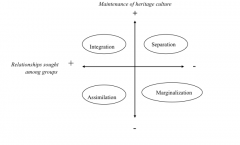![]()
![]()
![]()
Use LEFT and RIGHT arrow keys to navigate between flashcards;
Use UP and DOWN arrow keys to flip the card;
H to show hint;
A reads text to speech;
17 Cards in this Set
- Front
- Back
|
Contact for Prejudice
|
Works partly because it reduces anxiety, allows for cross-group friendships and allows for racial myths to be refuted. Small relationship between contact and prejudice, larger effect on majority rather than on minority groups
|
|
|
Decategorisation Hypothesis
|
Argues that contact forces people to look beyond category boundaries and to get to know each other as individuals
|
|
|
Problems with the Decategorisation Hypothesis
|
- Is it really feasible that people see each other entirely as individuals
- Model often advocated by members of majority but not minority - If people don't label each other as group members, how can the positive effects of contact be generalised outside the contact environment |
|
|
Common Ingroup Identity Model (CIIM)
|
Contact allows people to see beyond subgroup differences and to see each other as one big happy group
|
|
|
Problem with Common Ingroup Identity Model (CIIM)
|
Social Identity Theory: We like our groups to be distinct. The more similar you try to make groups, the more they are going to fight
|
|
|
The Dual Identity Model
|
Important to make people aware of what they share at the subordinate level, but people should be allowed to maintain their original subgroup identities as well. Multiculturalism is essentially political analogue of the Dual Identity Model.
|
|
|
Advantages of Dual Identity Model
|
- It minimises distinctiveness threat among subgroup members
- It means that any attitude change that is experienced during the contact situation is more likely to be generalised outside the contact environment |
|
|
Assimilation I
|
By getting people to focus entirely on their shared superordinate membership, subgroup identities will melt away. Cultural differences create the potential for hostility i.s. homogenisation = harmony
|
|
|
Melting-Pot Assimilation
|
Assumption that assimilation will happen naturally through extensive intergroup contact. Eventually old identities will fuse together into a new homogeneous identity e.g. American, Australian
|
|
|
Minority Group Assimilation
|
Assumption that minority groups should assimilate to the dominant culture
|
|
|
Problems with Assimilation
|
- May not be realistic to expect people to let go of their group memberships
- Groups with low status or power risk being appropriated and extinguished, i.e. the weak lose and the strong win - Forced assimilation can be psychologically painful for members of minority groups ... risk that distinctiveness threat will create reactive intergroup bias |
|
|
Multiculturalism Assumptions
|
- Man is a thinking and sensitive being: severing him from his roots could destroy an aspect of his personality and deprive society of some of the values he can bring to it
- Security of identity is a precondition for tolerance: attempts to eclipse valued identities will result in more aggressive intergroup behaviour - Difference is not inconsistent with unity |
|
|
Acculturation
|

How do immigrants fit into their host culture?
|
|
|
Separation
|
"Sticking Together". Ghettoisation
|
|
|
Integrations
|
Maintaining cultural heritage while still supporting and participating in the culture of the host country
|
|
|
Assimilation II
|
Completely revoking cultural heritage and adopting the values and cultures of the host country
|
|
|
Marginalisation
|
Retreat from all types of cultural identification. Individualisation
|

